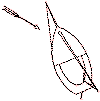By Dan Beard

Fig. 121
Squirming: Jib on Port Side,
Boom Close-hauled on Starboard Side
A thunderstorm is always an uncertain thing. There may be a veritable tornado hidden in the black clouds that we see rising on the horizon, or it may simply "iron out the wind" -that is, go grumbling overhead-and leave us becalmed, to get home the best way we can; generally by what the boys called a "white-ash breeze"-that is, by using the sweeps or oars.
On Long Island Sound a thunder-storm seems to have certain fixed rules of conduct. In the first place, it comes up from the leeward, or against the wind. Just before the storm strikes you for an instant the wind ceases and the sails flap idly. Then took out! for in nine cases out of ten you are struck the next moment by a sudden squall from exactly the opposite direction from which the wind blew a moment before.
What to Do
Make for the nearest port with all speed, and keep A man at the down haul ready at a moment's notice to lower sail. The moment the wind stops drop the sail and make everything snug, leaving only bare poles. When the thunder squall strikes you, be it ever so hard, you are now in little danger; and if the wind from the new quarter is not too fresh, you can hoist sail again and make the best of your way to the nearest port, where you can "get in out of the wet."
If the wind is quite fresh keep your peak down, and with a reefed sail speed on your way. If it is a regular howler, let your boat drive before the wind under bare poles until you can find shelter or until it blows over, and the worst mishap you are likely to incur is a good soaking from the rain.
Shortening Sail--Just as soon as the boat heels over too far for safety, or as soon as you are convinced that there is more wind than you need for comfortable sailing, it is time to take a reef-that is, to roll up the bottom of the sail to the row of little ropes or reefing points on the sail and make fast there. This, of course, makes a smaller sail, and that is what you wish. |
While under way it will be found impossible to reef a sail except when sailing close-hauled. So the boat is brought up into the wind by pushing the helm down, as if you intended to come about. When possible it is better to lower the sail entirely before attempting to put in a reef.
To Reef Without Lowering Sail
It sometimes happens that on account of the proximity of a lee shore, and the consequent danger of drifting in that direction, or for some other equally good reason, it is unadvisable to lower sail and lose headway. Under such circumstances the main sheet must be trimmed flat, keeping the boat as close as possible to the wind, the helm must be put up hard a-lee, and jib sheet trimmed to windward (Fig. 121).
When this is done the wind will hit the jib, "paying her head off," or pushing her bow to leeward, and this tendency is counteracted by the helm and mainsail, bringing the bow up into the wind. This keeps the boat squirming. Lower the mainsail until the row of reef points is just on a line with the boom, keeping to the windward of the sail. Tie the first point- that is, the one on the luff rope-then the one on the leach, being careful to stretch out he foot of the sail.
Then tie the remaining points, always making a square or reefing knot. Tie them to the jack stay on the boom or around he boom.
The Reef or Square Knot

Figs. 122 & 123
Square or Reef Knot
Is most frequently used, as its name implies, in reefing sails. First make a plain overhand knot, as in Fig. 122. Then repeat the operation by taking the end and passing it over and under the loop, drawing the parts tight, as shown in Fig. 123. Care should be observed in crossing the ends so that they will always lay fairly alongside the main parts. Otherwise the knot will prove a granny, and be comparatively worthless.
To Shake Out a Reef,
untie the knots, keeping to the windward of the sail. Untie the knot at the leach first, next the one at the luff, and then the remaining points. In lowering a sail you use a rope called the down haul.
Starboard Tack--When the main boom is over the port side. | |
Port Tack--When the main boom is over the starboard side. | |
Right of Way--All boats sailing on the starboard tack have the right of way over all those on the port tack. In other words, if you are on the starboard tack, those on the port tack must keep out of your way. Any boat sailing close-hauled has the right of way over a boat sailing free, |
Lights for Canoe
A canoe under sail at night should have an uncolored lantern hung to her mizen-mast to notify other craft that she is cut and objects to being run down. The light is put on the mizzen so that it may be behind the skipper and not dazzle him.